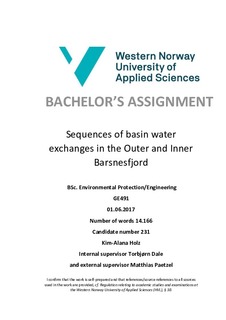| dc.description.abstract | Four hydrographical data sets of recent periods (1984-2016) are used to analyze the exchange processes of the basin water of the Inner and Outer Barsnesfjord in West-ern Norway. The basins are periodically anoxic. The data from the Barsnesfjord will be compared to the data from the Sogndalsfjord, because they are connected, to identify the water that is flowing in and renewing the water in the Barsnesfjord.
This thesis deals with analysis of hydrographical changes in Barsnesfjord and Sogndalsfjord with a prime focus on the parameters oxygen, density, and turbidity. In the Barsnesfjord water bodies, the data from the deeper parts (basin water) are of matter since the aim of this investigation is it to determine the sequence of deep/ba-sin water exchanges.
A gradual or sudden increase in the basin water of the oxygen concentrations as well as an increase in density, salinity values and changes in temperature and/or turbidity are signs for water exchanges. Such exchanges were discernable in three of the four data sets in the Barsnesfjord. Major inflow events to the Barsnesfjord happened in winter time in January/February in the years 1984, 1991 and 2014 but also between late March and late April of 1993. Another basin water exchange happened between October and November in 1984 in the Outer Barsnesfjord. But this was only a partial water exchange since the inflowing water only renewed water at 30 m depth. Major inflow events to the Sogndalsfjord were observed in summer time (June to August) in 1984 and 1991.
It should be mentioned that the focus in this thesis is on the parameter oxygen since it usually shows inflow events with an increase of values. During a basin water ex-change in the Outer Barsnesfjord in winter time of 2014, the oxygen concentration in the basin water increased from 1,2 mg/l to 6,51 mg/l due to an inflow of new water from the Sogndalsfjord. During a basin water exchange in the Inner Barsnesfjord in winter time 2014, the oxygen concentration increased from 0,09 mg/l to 5,92 mg/l at the depth of 60 m. In the Outer Barsnesfjord in 2014 however, a second inflow was not revealed by the oxygen concentrations. The density values revealed that there was another inflow or a continuation of a previous inflow.
IX
In addition to the determination of a succession of basin water exchange, it is also investigated how deep the renewing water will sink in the water column. Not always is the whole water column renewed, sometimes there is only a partial renewal of fjord water. The investigation showed that in some cases, water from the Sogndalsfjord only renewed water in the Outer Barsnesfjord at the depth of 30 m. This happened in 1984 as well as in the 2013 to 2014 period.
Important for the basin water exchanges between the Sogndalsfjord and the Barsnesfjord is the sound at Loftesnes (7,5 m depth) because the water has to go over the sill to get into the Barsnesfjord. A new bridge is being built there, which includes rockfills and two new pillars on the sound. It was concluded that if there are changes in the water exchange, they most probably will be positive since the removing of old bridge parts will increase the water exchange. | nb_NO |
